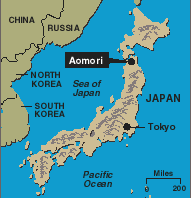
The New York Times
Now those mounds have been excavated, resolving crucial mysteries about the ancient hunter-gatherers who lived here 5,000 years ago. Just one mystery remains: to what extent are Yoshizaki and other modern Japanese descended from those ancient people?
 The New York Times | |
Now the site is perhaps the most important archeological dig in Japan, attracting half a million tourists a year and shedding new insights into prehistoric life here. Moreover, even after filling 40,000 boxes of material, archeologists say that they have at least 15 more years' work before they have completed their investigations here.
"The city of Aomori had very little history," mused Yoshizaki. "But now all of a sudden we have a great deal of history, and we're very proud of it."
The excavations have aroused enormous interest in Japan, where archeology is a national craze. Japan spends more than $1 billion annually in public funds to excavate some 13,000 sites each year, archeology books become best sellers, and leading experts often appear on television.
The issues are in some ways political as well as archeological because of the intense rivalries in East Asia. North Korea claims that it, not Africa, is where humans first appeared. South Koreans believe that it was their emigrants who brought civilization to Japan and that a Korean clan probably founded the Japanese imperial family. Chinese suggest that Xu Fu, an ancient Chinese envoy who was sent to Japan in the third century B.C., became Japan's first emperor, Jimmu.
These theories have not been a big hit in Japan. But the underlying competition may be one reason for the pride in new findings that the Jomon people who lived in Japan even earlier -- about 10,000 B.C. to 300 B.C. -- were much more sophisticated than anybody had expected.
Jomon sites have been found all over Japan, but the excavations here have been the most startling. The first discovery was of six enormous holes in the ground with the remains of wooden pillars one yard thick, evidently the base for some huge structure.
"This stunned people, and not only because it raised questions about how they cut and dragged the logs," said Yasuhiro Okada, a chief archeologist at the site in Aomori. "But also because it suggests a certain population and level of technology and social organization. This all showed much greater skills than we had assumed for these hunter-gatherers, and it was a stunning discovery for most Japanese."
Further investigation showed that the site was a settled village with hundreds of inhabitants and separate cemeteries for children and adults, and that its people had dabbled in agriculture by planting chestnuts and millet and other domesticated plants. There apparently was trade, for the dig turned up jade from 400 miles to the south and obsidian from the northern island of Hokkaido.
The traditional view had been that virtually all culture originated in Korea and China and then spread to Japan, but now some Japanese archeologists point to evidence that some innovations went the other way. They suggest that buckwheat farming, lacquerware-making and other innovations originated in Japan and then traveled to Korea and China.
"We know that we have learned many things from Korea and China," said Makoto Sahara, a historian and director general of the National Museum of Japanese History. "But not all things."
There is a complication, though. While modern Japanese feel pride in Jomon achievements, analysis of skeletons suggests that the Jomon did not look like modern Japanese.
Instead, they had features that made them look more like Caucasians and they seem to have resembled the Ainu, an ethnic group that still lives in tiny numbers in northern Japan. In the museum here in Aomori, Japanese tourists wandered by exhibits about the Jomon and gazed affectionately at pictures of what their Jomon ancestors are believed to have looked like -- even though the only one in the room who looked much like the pictures was an American.
One theory has been that waves of immigrants from China and Korea quickly displaced the Jomon people and their culture in about 300 B.C.They ushered in the Yayoi period, which emphasized rice paddy cultivation and whose people looked more like today's Japanese.
In the last decade, a growing body of skeletal, DNA and linguistic analysis has suggested that modern Japanese are the product of both Jomon people and the Yayoi immigrants from China and Korea -- and perhaps other population infusions as well.
Satoshi Horai, a scholar, argues that modern Japanese are a mix of about 35 percent Jomon and 65 percent Yayoi. That would mean that Japanese are descended mostly from Chinese and Koreans but also have an important Jomon component.
"The recent DNA studies clearly indicate the close genetic relationship between the Japanese on the main islands and the Koreans in particular," said Keiichi Omoto, a leading scholar on the origins of Japanese.
Scholars note that despite the perception in Japan and abroad that Japanese are homogeneous, there is considerable regional variation in physical appearance. In particular, Japanese in northern provinces tend to have rounder eyes and more body hair and wider faces, traits that may suggest a bit more Jomon heritage.
A museum at the site in Aomori offers a computer screen to advise visitors on the proportion of their blood that comes from the Jomon, based on their eyes and body hair and other characteristics.
"People in northern Japan can be 60 to 80 percent of Jomon origin, while those from western or southern Japan are 40 percent Jomon or less," said Okada, the archeologist. He added: "The Jomon people were the real ancestors of the Japanese. They formed the base."